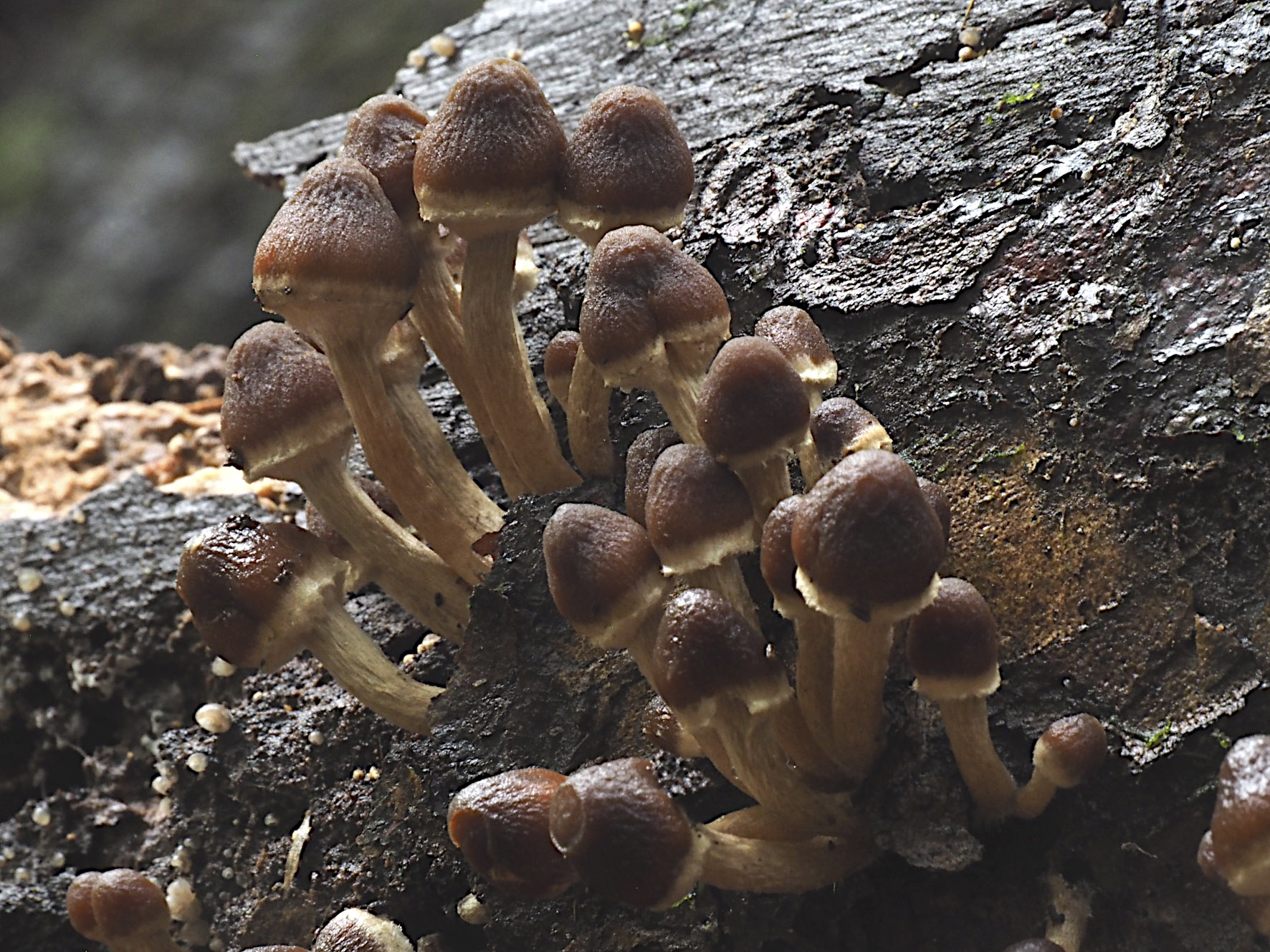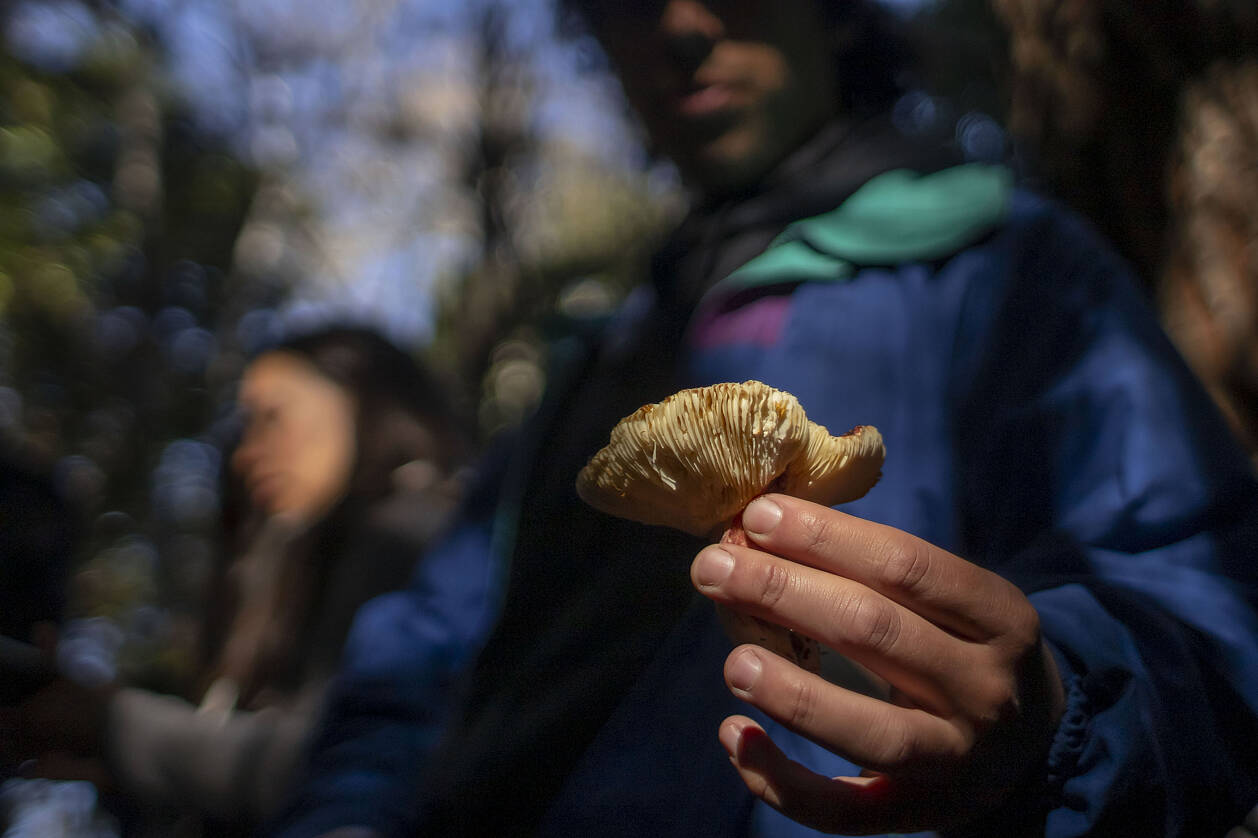Fungus species discovered, previously documented only in Chiloé and Valdivia

An elusive species of fungus, recorded only in the south of the country, was discovered in the native forest of the Campus Naturaleza project a few weeks ago, in the surroundings of the Patrimonial Campus of the University of Concepción. The research of Professor Götz Palfner, professor of the Faculty of Natural and Oceanographic Sciences of the University, together with two students, becomes the northernmost discovery of the species Psathyrella chiloensis Singer.
“There is no previous drawing or photo of the species, only the textual description, published in 1969.” Professor Götz Palfner, a German biologist who has been in Chile for many years as a research professor in the Department of Botany, Faculty of Natural Sciences and Oceanography of the University of Concepción, refers to the unprecedented discovery he made a few weeks ago, of which there is not even a previous graphic record.
While researching in the native forest remnant, which today forms part of the Universidad de Concepción Campus Naturaleza project, she recorded, together with students Scarleth Jerez and Carolina Sobarzo, three native species of fungi that had not previously been seen in the area.
“We went to the native forest of Campus Naturaleza and we were checking the soil, wood, decomposition where Carolina had discovered a fallen trunk of a native tree with different species of fungi, there were more mushrooms in the same spot, there on stumps of native trees.”
“To our surprise, we found three native species of fungi that had not been previously recorded in the native forest. One of them, the most important, is called Psathyrella chiloensis and was originally discovered in Chiloé in 1967 by Rolf Singer, a prominent mycologist of the time. Apart from this type material, there is only one other previous record from the Valdivia area, published in 1998 by Eduardo Valenzuela and collaborators. With this record in Campus Naturaleza, the known distribution of the species increases considerably, because it is the most northern record known.”
The native forest located just a few minutes from the University is often visited by researchers and academics from different faculties and corresponds to a relict ecosystem of deciduous forest in Concepción. It is home to unique and varied tree species, which mark the transition between the native forests of the central and southern areas of the country, making it a prime conservation space as part of the Campus Naturaleza Universidad de Concepción project.

Image, guided tour of the native forest, Campus Naturaleza project, University of Concepción
Kingdom fungi
Regarding the importance of fungi as a relevant actor in native ecosystems, Professor Palfner, who is an associate academic of the Campus Naturaleza project, highlights that they interact with other components of the forest, but “they play their greatest ecological role with plants, in all types of vegetation. Fungi form their own kingdom, the fungi kingdom. This is distinguished from animals, from plants, they are a separate group of organisms, but, nevertheless, they form multiple associations with plants. Wherever we find vegetation, we always find fungi, which play different roles, as decomposers of plant remains, but also as symbionts, mutualistic symbionts, and also symbionts that parasitize plants.”
He argues that native forests, by having more plant diversity, also host more fungal diversity. “In monoculture plantations there is much less fungal diversity. Native forests in Chile and native forests everywhere in the world have millions of years of evolutionary history and species diversification. So they are much richer in fungal species due to their evolutionary history than an exotic pine or eucalyptus plantation, which consists of trees that were only introduced here perhaps 50 or at most 100 years ago.”
“We found some fungi in pine plantations, in eucalyptus plantations, that are even specifically associated with these exotic trees, but they are not compatible with native trees. So first of all, in exotic plantations we have much less diversity of fungi and they are also alochthonous species, as we scientists call them, foreign species that come from other parts of the world and are not compatible with the native forest.”
Edible and poisonous species
The academic maintains that in the hills near the UdeC they have always found a great variety of species, “some edible ones too, such as the changles, for example, of the Ramaria genus. There is even loyo. These are the best edible species.”
He reveals that there is no law or general rule that allows one to safely separate an edible mushroom from a toxic or poisonous mushroom. “I always say that there are a couple of rules that people who like to collect wild mushrooms to eat should always respect. First, collect only the species that they really know and recognize, which they know are edible and which are not easy to confuse with unknown species or even with toxic species.”
“And the second rule is to learn the poisonous species, because there are few. In fact, in Chile we only have two or three species of toxic fungi that are dangerous, that can cause fatal poisoning. They only grow in pine plantations or under other exotic trees and not in the native forest. However, it is not a strict limit, because the problem is that pines also invade the native forest and invade it along with their associated fungi. So where there is pine next to native forest, it cannot be ruled out that a poisonous species of pine may suddenly appear in the native forest as well,” he says.
“There is also a species of Amanita that has a light yellow cap and the rest of the mushroom is white, which is called Amanita gemmata, the toxic variety, or Toxic Amanita, as a synonym. It was named this because it is suspected of having caused serious, even fatal, poisoning in south-central Chile. There is another that has a red cap, sometimes quite large and with white dots on top. That is the Amanita muscaria and it is indeed toxic too, but it has a less dangerous toxin than the deadly amanitas called ibotenic acid or another form of the same toxin called muscimol. They cause symptoms such as vomiting, nausea, vertigo, and also headaches, but they are not fatal.”
“He emphasizes that the most dangerous amanita is the Amanita phalloides, which is green and has toxins that destroy liver and kidney tissue. That is why it causes the death of the patient, of the person who ingests it. Specifically, the deadly species are those that produce this necrosis of the liver and kidneys.”
Regarding the different colours of mushrooms, his opinion is that all that remains is to marvel. “More than anything, enjoy the great variety of colours that mushrooms have, because colour says nothing about whether the mushroom is edible or poisonous. There are some beliefs, there are people who say, for example, that when you cut a mushroom and it turns blue it is poisonous, but that is not true. Colour has no direct relationship with the edibility or toxicity of the mushroom. I would say that it is almost a playground of nature, where it experiments with different and varied colours.”
Professor Palfner does emphasize the ecological importance of the native forest of Campus Naturaleza, “because it houses a high diversity of fungi, both decomposers and fungi that form mycorrhizae, as well as parasites, which are endemic, meaning that they only exist in the native forest of Chile, perhaps in part of Argentina as well, but nowhere else in the world.”
“For this reason, this is part of a unique biological heritage that we have here in the south of Chile and that we find here in the heart of the city of Concepción, in the remnants of native forest that have survived. We must care for and conserve both the forest and all the endemic fungi that are associated with it,” argues the specialist.
“I think that finding three little-known native species in an area of approximately 20 square metres is a clear indicator that this relic is a refuge for many native species, and I think that increases its conservation value considerably. I have been visiting the forest for many years and we have often found species that we had not previously discovered or seen,” he says.


